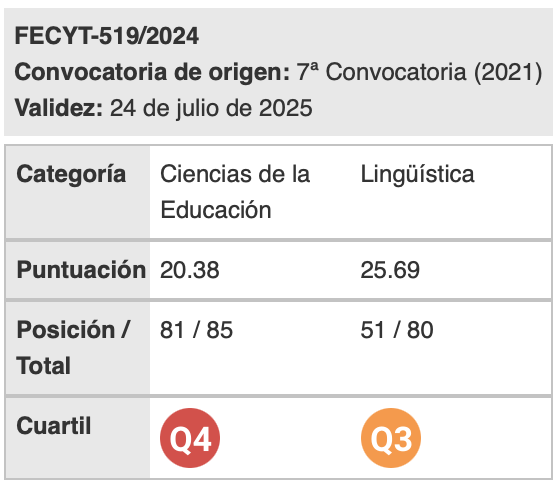Persuasion markers and ideology in eighteenth century philosophy texts (CEPhiT)
Palabras clave:
diachrony, scientific English, multidimensional analysis, persuasion markers, female writingResumen
The aim of this paper is to analyse the presence of persuasion markers in the eighteenth century texts of the Corpus of English Philosophy Texts (CEPhiT), a sub-corpus of the Coruña Corpus.2 It is also my intention to ascertain to what an extent the genteel, social and religious ideology of the period is present in both the texts and in prefaces to these works written by the authors themselves. The paper will be organized as follows. Section One describes the function of persuasion in the author-reader relationship of eighteenth century English-speaking countries, as well as the dominant ideological postulates which underpin it. Section Two presents the methodology and the corpus material selected for the analysis, Biber’s Multidimensional Analysis (MD henceforth) and CEPhiT, respectively. Section Three sets out the analysis of data, through which I offer a quantitative approach to persuasive strategies followed by a functional interpretation, paying special attention to the text-type/genre variable and comparing overall results with those that refer specifically to female authors. Conclusions and final remarks will be discussed in Section Four.
Descargas
Citas
Allen, B., Qin, J. & Lancaster, F. W. (1994). Persuasive communities: A longitudinal analysis of references in the Philosophical Transactions of the Royal Society. Social Studies of Science, 24, 279-310.
Atkinson, D. (1999). Scientific discourse in sociohistorical context. The Philosophical Transactions of the Royal Society of London, 1675-1975. Mahwah, New Jersey: Lawrence Erlbaum Associates, Publishers.
Biber, D. (1988). Variation across speech and writing. Cambridge, UK: Cambridge University Press.
Biber, D. (1995). Dimensions of register variation: A cross-linguistic comparison. Cambridge, UK: Cambridge University Press.
Biber, D., Johansson, S., Leech, G., Conrad, S. & Finegan, E. (1999). The Longman grammar of spoken and written English. London: Longman.
Biber, D., Connor, U. & A. Upton, T. (2007). Discouse on the move: using corpus analysis to describe corpus structure. Amsterdam/Philadelphia: John Benjamins Publishing Company.
Boyle, R. (1661). “A Proemial Essay, wherein, with some considerations touching experimental essays in general is interwoven such an introduction to all those written by the author as is necessary to be perus’d for the better understanding of them. From certain physiological essays written at distant times, and on several occasions. London: Henry Herringman (pp.11-12).
Bülow-MØller, A. M. (2004). Persuasion in business negotiations. In Halmari, H. & Virtanen, T. (Eds.), Persuasion across genres: a linguistic approach (pp. 27-58). Amsterdam: John Benjamins.
Coates, J. (1983). The semantics of the modal auxiliaries. London: Croom Helm. Crespo, B., & Moskowich, I. (2010). CETA in the context of the Coruña
Corpus. Literary and Linguistic Computing, 25(2), 153-164.
Crespo, B. (forthcoming). Women writing science. The case of eighteenth century authors.
Duszak, A. (Ed.). (1997). Culture and styles of academic discourse. Berlin: Mouton de Gruyter.
Görlach, M. (2004). Text types and the history of English. Berlin: Mouton de Gruyter.
Hyland, K. (1998). Hedging in scientific research articles. Amsterdam: John Benjamins. Hyland, K. (2005). Metadiscourse: Exploring interaction in writing. London/New
York: Continuum.
Lyons, J. (1968). Introduction to theoretical linguistics. Cambridge, UK: Cambridge University Press.
Moskowich, I. & Crespo, B. (2007). Presenting the Coruña Corpus: A collection of samples for the historical study of English scientific writing. In Pérez Guerra, J. et al. (Eds.), ‘Of varying language and opposing creed’: New insights into Late Modern English (pp. 341-357). Bern: Peter Lang.
Oxford English Dictionary. (1989). 2nd ed. online version November 2010. http://www.oed.com, Accessed 15 December 2010.
Quirk, R., Greenbaum, S., Leech, G. & Svartvik, J. (1985). A comprehensive grammar of the English language. London: Longman.
Shapin, S. (1984). Pump and circumstance: Robert Boyle’s literary technology. Social Studies of Science 14(4), 481-520.
Sokól, M. (2006). Discoursal construction of academic identity in cyberspace (On the example of an e-seminar). Doctoral dissertation written in The Department of English, Szczecin University, Szczecin.
Thompson, V., Evans, J. St. B. T. & Handley, S. J. (2005). Persuading and dissuading by conditional argument. Journal of Memory and Language 53, 238-257.
Vassileva, I. (2000). Who is the author? A contrastive analysis of authorial presence in English, German, French, Russian and Bulgarian academic discourse. Sankt Augustin: Asgard.
Unless, prep., conj., and n.
Second edition, 1989; online version March 2011. <http://www.oed.com:80/ Entry/215075>; accessed 26 May 2011. Earlier version first published in New English Dictionary, 1924.
Ought, v.
Third edition, December 2004; online version March 2011. <http://www.oed. com:80/Entry/133336>, accessed 27 May 2011.
Descargas
Publicado
Cómo citar
Número
Sección
Licencia
Aquellos autores/as que tengan publicaciones con esta revista, aceptan los términos siguientes:
- Los autores/as conservarán sus derechos de autor y garantizarán a la revista el derecho de primera publicación de su obra, el cuál estará simultáneamente sujeto a la Licencia de reconocimiento de Creative Commons que permite a terceros compartir la obra siempre que se indique su autor y su primera publicación esta revista.
- Los autores/as podrán adoptar otros acuerdos de licencia no exclusiva de distribución de la versión de la obra publicada (p. ej.: depositarla en un archivo telemático institucional o publicarla en un volumen monográfico) siempre que se indique la publicación inicial en esta revista.
- Se permite y recomienda a los autores/as difundir su obra a través de Internet (p. ej.: en archivos telemáticos institucionales o en su página web) antes y durante el proceso de envío, lo cual puede producir intercambios interesantes y aumentar las citas de la obra publicada. (Véase El efecto del acceso abierto).

Revista de Lenguas para fines específicos is licensed under a Creative Commons Reconocimiento-NoComercial-SinObraDerivada 4.0 Internacional License.






















